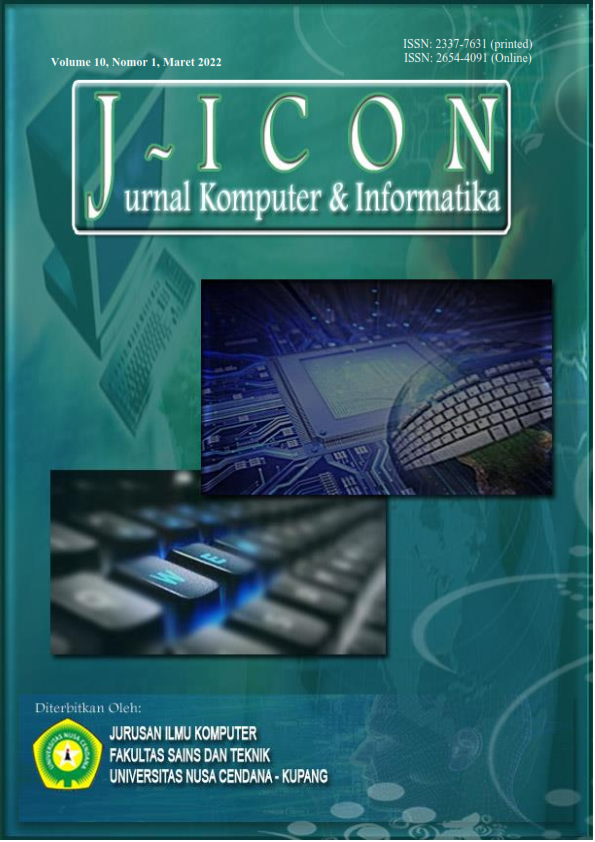Determining the Success of Online Learning During the Covid-19 Pandemic Using the C4.5 Algorithm at Stikom Tunas Bangsa
Abstract
The C4.5 algorithm is an algorithm for classifying, grouping and predicting. The calculation of the RapidMiner C4.5 algorithm produces the same results according to the decision tree in the case of online learning success. Manual calculations using RapidMiner produce 23 successful online learning rules. Decision trees make it easier to understand the attribute that is prioritized as the most important attribute, root class and leaf class. The C4.5 algorithm as the application of data mining can result in successful online learning decisions during the Covid-19 pandemic. The decision tree in the case of the success of online learning during the Covid-19 pandemic is said to be successful.
Downloads
References
H. Putria, L. H. Maula, and D. A. Uswatun, “Analisis Proses Pembelajaran dalam Jaringan (DARING) Masa Pandemi Covid- 19 Pada Guru Sekolah Dasar,” Jurnal Basicedu, vol. 4, no. 4, pp. 861–870, 2020, doi: 10.31004/basicedu.v4i4.460.
U. Fitriani, B. Karyadi, and I. Ansori, “Penerapan Model Discovery Learning Untuk Meningkatkan Pemahaman Konsep Biologi Siswa Smp,” Diklabio: Jurnal Pendidikan dan Pembelajaran Biologi, vol. 1, no. 1, pp. 82–90, 2017, doi: 10.33369/diklabio.1.1.82-90.
R. W. Sari, A. P. Windarto, S. P. Keputusan, P. Kreatifitas, M. Pkm, and A. D. A. N. Pembahasan, “Penerapan Electree Pada Seleksi Proposal Program Kreativitas Mahasiswa (PKM) di STIKOM Tunas Bangsa,” Seminar Nasional Teknologi Komputer & Sains (SAINTEKS) SAINTEKS 2019, pp. 800–806, 2019.
Y. S. Luvia, A. P. Windarto, S. Solikhun, and D. Hartama, “Penerapan Algoritma C4.5 Untuk Klasifikasi Predikat Keberhasilan Mahasiswa Di Amik Tunas Bangsa,” Jurasik (Jurnal Riset Sistem Informasi dan Teknik Informatika), vol. 1, no. 1, pp. 75–79, 2017, doi: 10.30645/jurasik.v1i1.12.
D. Jollyta, W. Ramdhan, and M. Zarlis, “Konsep Data Mining dan Penerapan.” p. 162, 2020.
A. M. Siregar and A. Puspabhuana, Data mining Pengolahan Data Menjadi Informasi dengan rapidMiner. 2017.
E. Buulolo, “Data Mining Untuk Perguruan Tinggi.” p. 91, 2020.
D. Nofriansyah and G. W. Nurcahyo, “Algoritma Data Mining Dan Pengujian,” Algoritma Data Mining dan Pengujian. pp. 1–3, 2019.
R. W. Nasution, I. O. Kirana, I. Gunawan, and I. P. Sari, “Penerapan Data Mining Untuk Pengelompokan Minat Konsumen Terhadap Pengguna Jasa Pengiriman Pada PT. Jalur Nugraha Ekakurir (JNE) Pematangsiantar,” vol. 1, no. 4, pp. 274–281, 2021.
A. Maulana and A. A. Fajrin, “Penerapan Data Mining Untuk Analisis Pola Pembelian Konsumen Dengan Algoritma Fp-Growth Pada Data Transaksi Penjualan Spare Part Motor,” Klik - Kumpulan Jurnal Ilmu Komputer, vol. 5, no. 1, p. 27, 2018, doi: 10.20527/klik.v5i1.100.
E. Prasetyowati, “DATA MINING Pengelompokan Data untuk Informasi dan Evaluasi,” Duta Media Publishing. pp. 97–98, 2017.
J. SUNTORO, “DATA MINING : Algoritma dan Implementasi dengan Pemrograman php.” p. 179, 2019.
A. Muzakir and R. A. Wulandari, “Model Data Mining sebagai Prediksi Penyakit Hipertensi Kehamilan dengan Teknik Decision Tree,” Scientific Journal of Informatics, vol. 3, no. 1, pp. 19–26, 2016, doi: 10.15294/sji.v3i1.4610.
Y. Mardi, “Data Mining : Klasifikasi Menggunakan Algoritma C4.5,” Jurnal Edik Informatika, vol. 2, no. 2, pp. 213–219, 2017.
Copyright (c) 2022 Eko Ahadi, Indra Gunawan, Ika Okta Kirana, Dedy Hartama, Muhammad Ridwan Lubis

This work is licensed under a Creative Commons Attribution 4.0 International License.
The author submitting the manuscript must understand and agree that if accepted for publication, authors retain copyright and grant the journal right of first publication with the work simultaneously licensed under a Creative Commons Attribution (CC-BY) 4.0 License that allows others to share the work with an acknowledgment of the work’s authorship and initial publication in this journal.
 Eko Ahadi(1*)
Eko Ahadi(1*)




